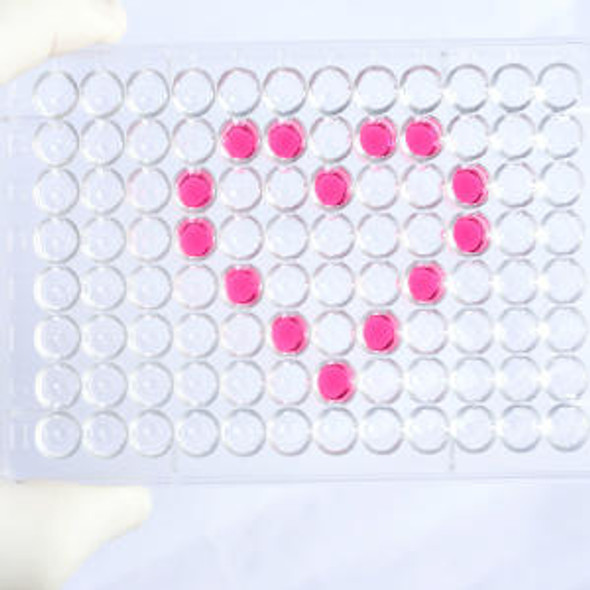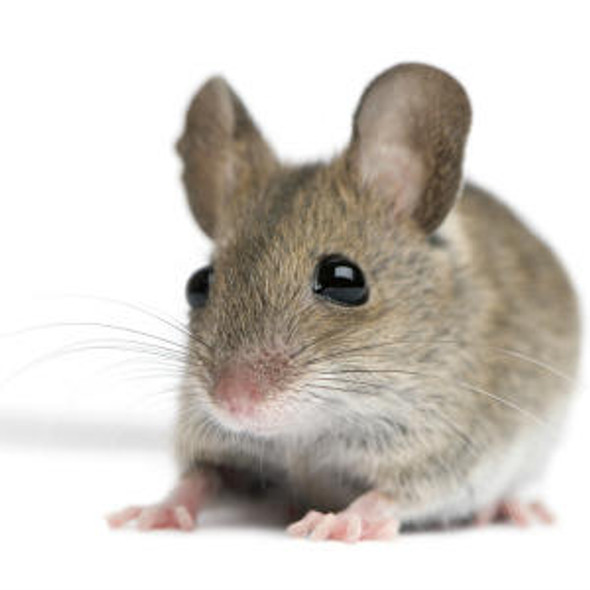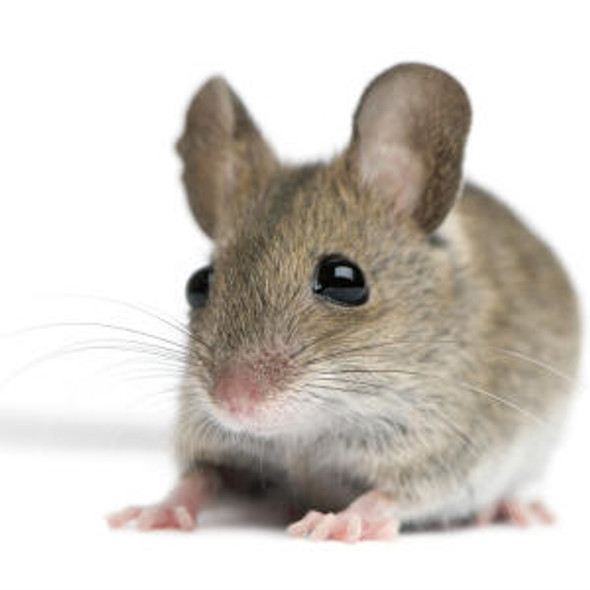Mouse Vascular endothelial growth factor receptor 3 (Flt4) ELISA Kit
- SKU:
- MOEB0142
- Product Type:
- ELISA Kit
- Size:
- 96 Assays
- Uniprot:
- P35917
- ELISA Type:
- Sandwich
- Synonyms:
- FLT4, VEGF R3, FLT-4
- Reactivity:
- Mouse
Description
| Product Name: | Mouse Vascular endothelial growth factor receptor 3 (Flt4) ELISA Kit |
| Product Code: | MOEB0142 |
| Alias: | Vascular endothelial growth factor receptor 3, VEGFR-3, Fms-like tyrosine kinase 4, FLT-4, Tyrosine-protein kinase receptor FLT4, Flt4, Flt-4, 2.7.10.1, Vegfr3 |
| Uniprot: | P35917 |
| Reactivity: | Mouse |
| Range: | Please contact us for more information |
| Detection Method: | Sandwich |
| Size: | 96 Assay |
| Storage: | Please see kit components below for exact storage details |
| Note: | For research use only |
| UniProt Protein Function: | VEGFR3: Tyrosine-protein kinase that acts as a cell-surface receptor for VEGFC and VEGFD, and plays an essential role in adult lymphangiogenesis and in the development of the vascular network and the cardiovascular system during embryonic development. Promotes proliferation, survival and migration of endothelial cells, and regulates angiogenic sprouting. Signaling by activated FLT4 leads to enhanced production of VEGFC, and to a lesser degree VEGFA, thereby creating a positive feedback loop that enhances FLT4 signaling. Modulates KDR signaling by forming heterodimers. The secreted isoform 3 may function as a decoy receptor for VEGFC and/or VEGFD and play an important role as a negative regulator of VEGFC-mediated lymphangiogenesis and angiogenesis. Binding of vascular growth factors to isoform 1 or isoform 2 leads to the activation of several signaling cascades; isoform 2 seems to be less efficient in signal transduction, because it has a truncated C-terminus and therefore lacks several phosphorylation sites. Mediates activation of the MAPK1/ERK2, MAPK3/ERK1 signaling pathway, of MAPK8 and the JUN signaling pathway, and of the AKT1 signaling pathway. Phosphorylates SHC1. Mediates phosphorylation of PIK3R1, the regulatory subunit of phosphatidylinositol 3- kinase. Promotes phosphorylation of MAPK8 at 'Thr-183' and 'Tyr- 185', and of AKT1 at 'Ser-473'. Interacts with VEGFC and VEGFD. Monomer in the absence of bound VEGFC or VEGFD. Homodimer in the presence of bound VEGFC or VEGFD. Can also form a heterodimer with KDR. Interacts with PTPN14; the interaction is enhanced by stimulation with VEGFC. Interacts with CRK, GRB2, PTK2/FAK1, SHC1, PIK3R1 and PTPN11/SHP- 2. Identified in a complex with SRC and ITGB1. Detected in endothelial cells. Widely expressed. Detected in fetal spleen, lung and brain. Detected in adult liver, muscle, thymus, placenta, lung, testis, ovary, prostate, heart, and kidney. Present in an inactive conformation in the absence of bound ligand. Binding of VEGFC or VEGFD leads to dimerization and activation by autophosphorylation on tyrosine residues. Inhibited by MAZ51. Belongs to the protein kinase superfamily. Tyr protein kinase family. CSF-1/PDGF receptor subfamily. 3 isoforms of the human protein are produced by alternative splicing. |
| UniProt Protein Details: | Protein type:Protein kinase, TK; Kinase, protein; Membrane protein, integral; EC 2.7.10.1; Protein kinase, tyrosine (receptor); TK group; VEGFR family Cellular Component: cytoplasm; integral to membrane; integral to plasma membrane; membrane; nucleus; plasma membrane; receptor complex Molecular Function:ATP binding; growth factor binding; kinase activity; nucleotide binding; protein binding; protein kinase activity; protein phosphatase binding; protein-tyrosine kinase activity; transferase activity; transmembrane receptor protein tyrosine kinase activity; vascular endothelial growth factor receptor activity Biological Process: alveolus development; angiogenesis; blood vessel morphogenesis; lymph vessel development; lymphangiogenesis; negative regulation of apoptosis; peptidyl-tyrosine phosphorylation; phosphorylation; positive regulation of cell growth; positive regulation of cell proliferation; positive regulation of endothelial cell proliferation; positive regulation of JNK cascade; positive regulation of MAPKKK cascade; positive regulation of protein amino acid phosphorylation; protein amino acid autophosphorylation; protein amino acid phosphorylation; respiratory gaseous exchange; respiratory system process; sprouting angiogenesis; transmembrane receptor protein tyrosine kinase signaling pathway; vascular endothelial growth factor receptor signaling pathway; vasculature development |
| UniProt Code: | P35917 |
| NCBI GenInfo Identifier: | 544322 |
| NCBI Gene ID: | 14257 |
| NCBI Accession: | P35917.1 |
| UniProt Related Accession: | P35917 |
| Molecular Weight: | 153,016 Da |
| NCBI Full Name: | Vascular endothelial growth factor receptor 3 |
| NCBI Synonym Full Names: | FMS-like tyrosine kinase 4 |
| NCBI Official Symbol: | Flt4 |
| NCBI Official Synonym Symbols: | Chy; Flt-4; VEGFR3; VEGFR-3; AI323512 |
| NCBI Protein Information: | vascular endothelial growth factor receptor 3 |
| UniProt Protein Name: | Vascular endothelial growth factor receptor 3 |
| UniProt Synonym Protein Names: | Fms-like tyrosine kinase 4; FLT-4; Tyrosine-protein kinase receptor FLT4 |
| Protein Family: | Vascular endothelial growth factor receptor |
| UniProt Gene Name: | Flt4 |
| UniProt Entry Name: | VGFR3_MOUSE |
| Component | Quantity (96 Assays) | Storage |
| ELISA Microplate (Dismountable) | 8×12 strips | -20°C |
| Lyophilized Standard | 2 | -20°C |
| Sample Diluent | 20ml | -20°C |
| Assay Diluent A | 10mL | -20°C |
| Assay Diluent B | 10mL | -20°C |
| Detection Reagent A | 120µL | -20°C |
| Detection Reagent B | 120µL | -20°C |
| Wash Buffer | 30mL | 4°C |
| Substrate | 10mL | 4°C |
| Stop Solution | 10mL | 4°C |
| Plate Sealer | 5 | - |
Other materials and equipment required:
- Microplate reader with 450 nm wavelength filter
- Multichannel Pipette, Pipette, microcentrifuge tubes and disposable pipette tips
- Incubator
- Deionized or distilled water
- Absorbent paper
- Buffer resevoir
*Note: The below protocol is a sample protocol. Protocols are specific to each batch/lot. For the correct instructions please follow the protocol included in your kit.
Allow all reagents to reach room temperature (Please do not dissolve the reagents at 37°C directly). All the reagents should be mixed thoroughly by gently swirling before pipetting. Avoid foaming. Keep appropriate numbers of strips for 1 experiment and remove extra strips from microtiter plate. Removed strips should be resealed and stored at -20°C until the kits expiry date. Prepare all reagents, working standards and samples as directed in the previous sections. Please predict the concentration before assaying. If values for these are not within the range of the standard curve, users must determine the optimal sample dilutions for their experiments. We recommend running all samples in duplicate.
| Step | |
| 1. | Add Sample: Add 100µL of Standard, Blank, or Sample per well. The blank well is added with Sample diluent. Solutions are added to the bottom of micro ELISA plate well, avoid inside wall touching and foaming as possible. Mix it gently. Cover the plate with sealer we provided. Incubate for 120 minutes at 37°C. |
| 2. | Remove the liquid from each well, don't wash. Add 100µL of Detection Reagent A working solution to each well. Cover with the Plate sealer. Gently tap the plate to ensure thorough mixing. Incubate for 1 hour at 37°C. Note: if Detection Reagent A appears cloudy warm to room temperature until solution is uniform. |
| 3. | Aspirate each well and wash, repeating the process three times. Wash by filling each well with Wash Buffer (approximately 400µL) (a squirt bottle, multi-channel pipette,manifold dispenser or automated washer are needed). Complete removal of liquid at each step is essential. After the last wash, completely remove remaining Wash Buffer by aspirating or decanting. Invert the plate and pat it against thick clean absorbent paper. |
| 4. | Add 100µL of Detection Reagent B working solution to each well. Cover with the Plate sealer. Incubate for 60 minutes at 37°C. |
| 5. | Repeat the wash process for five times as conducted in step 3. |
| 6. | Add 90µL of Substrate Solution to each well. Cover with a new Plate sealer and incubate for 10-20 minutes at 37°C. Protect the plate from light. The reaction time can be shortened or extended according to the actual color change, but this should not exceed more than 30 minutes. When apparent gradient appears in standard wells, user should terminatethe reaction. |
| 7. | Add 50µL of Stop Solution to each well. If color change does not appear uniform, gently tap the plate to ensure thorough mixing. |
| 8. | Determine the optical density (OD value) of each well at once, using a micro-plate reader set to 450 nm. User should open the micro-plate reader in advance, preheat the instrument, and set the testing parameters. |
| 9. | After experiment, store all reagents according to the specified storage temperature respectively until their expiry. |
When carrying out an ELISA assay it is important to prepare your samples in order to achieve the best possible results. Below we have a list of procedures for the preparation of samples for different sample types.
| Sample Type | Protocol |
| Serum | If using serum separator tubes, allow samples to clot for 30 minutes at room temperature. Centrifuge for 10 minutes at 1,000x g. Collect the serum fraction and assay promptly or aliquot and store the samples at -80°C. Avoid multiple freeze-thaw cycles. If serum separator tubes are not being used, allow samples to clot overnight at 2-8°C. Centrifuge for 10 minutes at 1,000x g. Remove serum and assay promptly or aliquot and store the samples at -80°C. Avoid multiple freeze-thaw cycles. |
| Plasma | Collect plasma using EDTA or heparin as an anticoagulant. Centrifuge samples at 4°C for 15 mins at 1000 × g within 30 mins of collection. Collect the plasma fraction and assay promptly or aliquot and store the samples at -80°C. Avoid multiple freeze-thaw cycles. Note: Over haemolysed samples are not suitable for use with this kit. |
| Urine & Cerebrospinal Fluid | Collect the urine (mid-stream) in a sterile container, centrifuge for 20 mins at 2000-3000 rpm. Remove supernatant and assay immediately. If any precipitation is detected, repeat the centrifugation step. A similar protocol can be used for cerebrospinal fluid. |
| Cell culture supernatant | Collect the cell culture media by pipette, followed by centrifugation at 4°C for 20 mins at 1500 rpm. Collect the clear supernatant and assay immediately. |
| Cell lysates | Solubilize cells in lysis buffer and allow to sit on ice for 30 minutes. Centrifuge tubes at 14,000 x g for 5 minutes to remove insoluble material. Aliquot the supernatant into a new tube and discard the remaining whole cell extract. Quantify total protein concentration using a total protein assay. Assay immediately or aliquot and store at ≤ -20 °C. |
| Tissue homogenates | The preparation of tissue homogenates will vary depending upon tissue type. Rinse tissue with 1X PBS to remove excess blood & homogenize in 20ml of 1X PBS (including protease inhibitors) and store overnight at ≤ -20°C. Two freeze-thaw cycles are required to break the cell membranes. To further disrupt the cell membranes you can sonicate the samples. Centrifuge homogenates for 5 mins at 5000xg. Remove the supernatant and assay immediately or aliquot and store at -20°C or -80°C. |
| Tissue lysates | Rinse tissue with PBS, cut into 1-2 mm pieces, and homogenize with a tissue homogenizer in PBS. Add an equal volume of RIPA buffer containing protease inhibitors and lyse tissues at room temperature for 30 minutes with gentle agitation. Centrifuge to remove debris. Quantify total protein concentration using a total protein assay. Assay immediately or aliquot and store at ≤ -20 °C. |
| Breast Milk | Collect milk samples and centrifuge at 10,000 x g for 60 min at 4°C. Aliquot the supernatant and assay. For long term use, store samples at -80°C. Minimize freeze/thaw cycles. |










